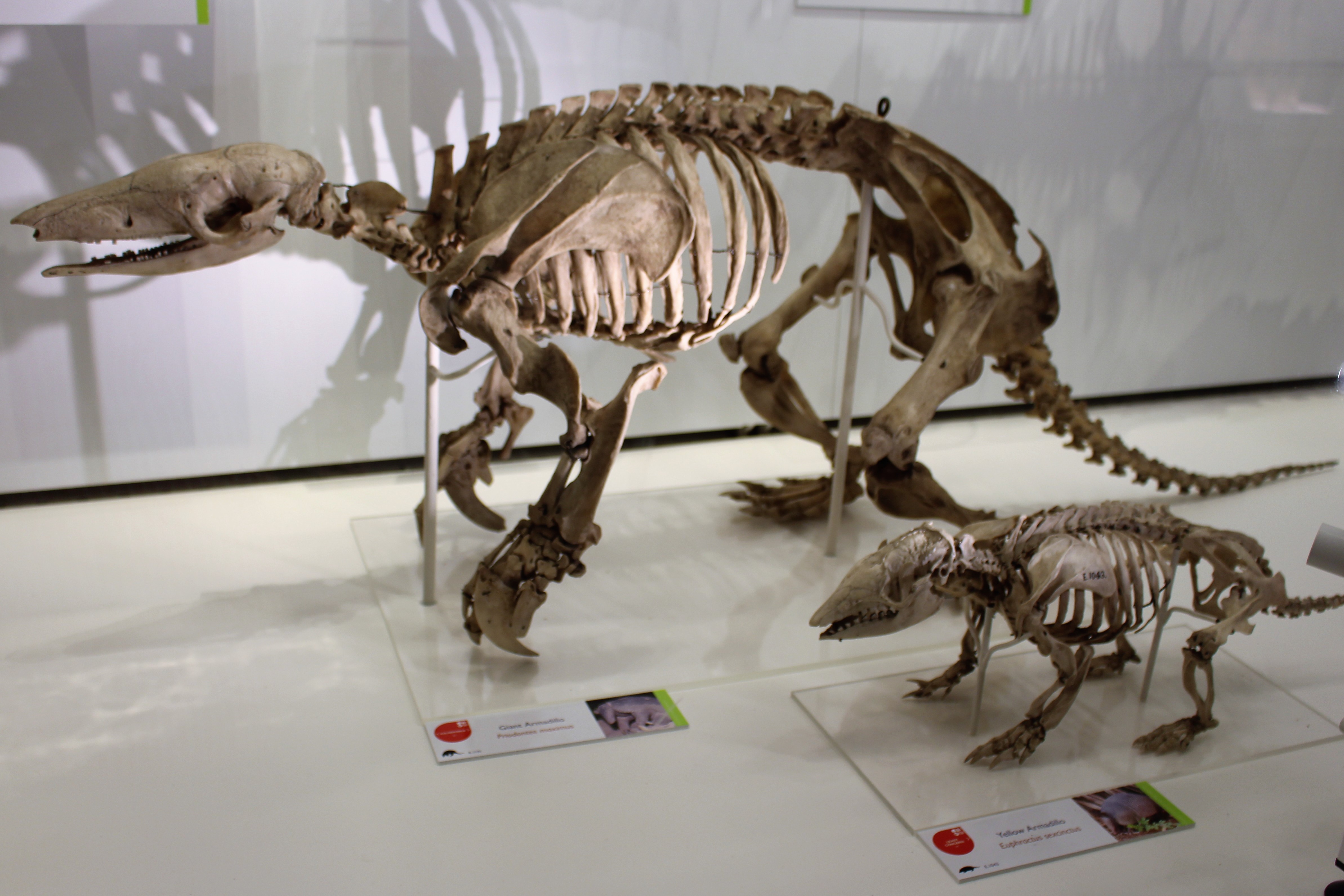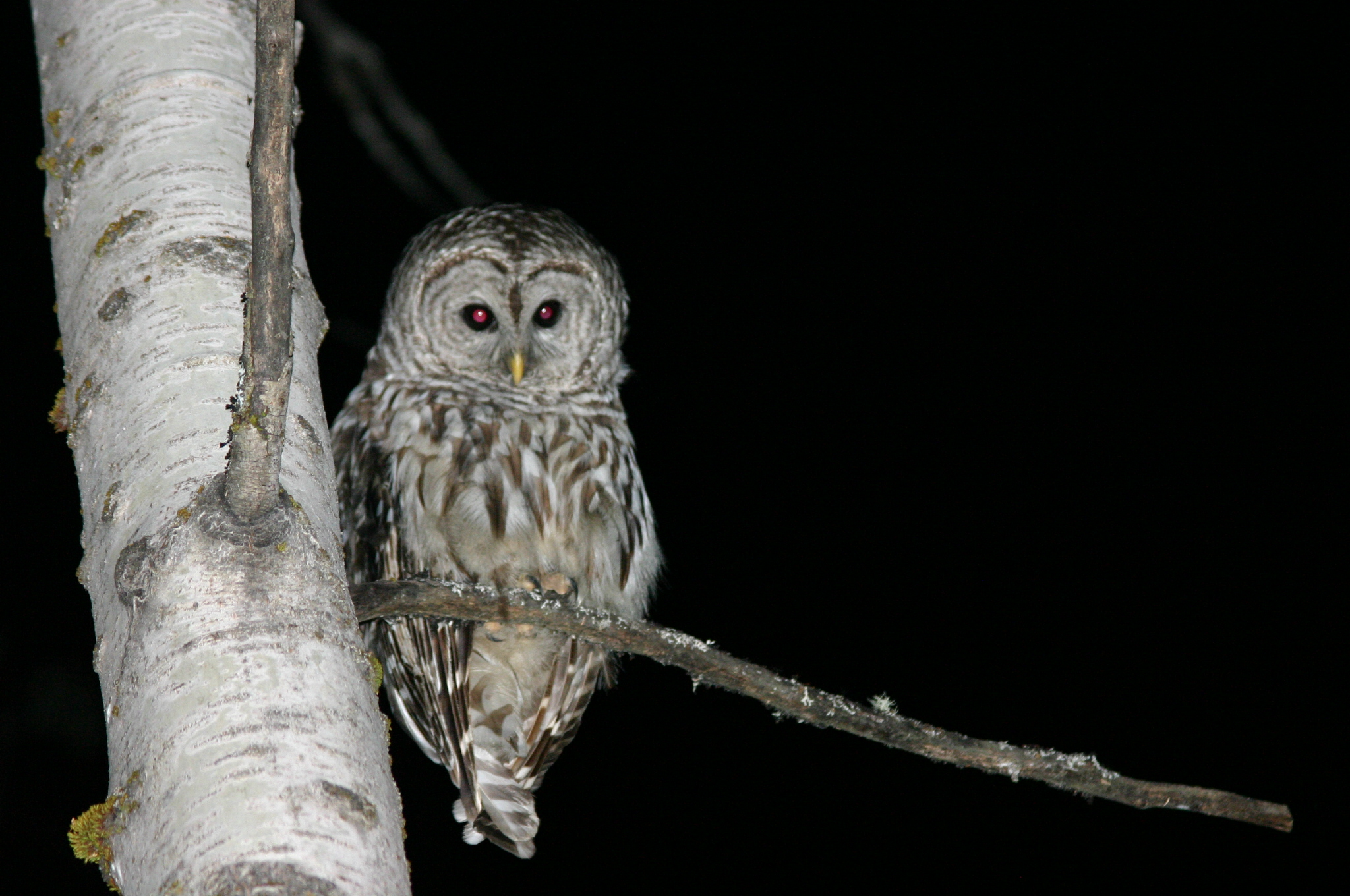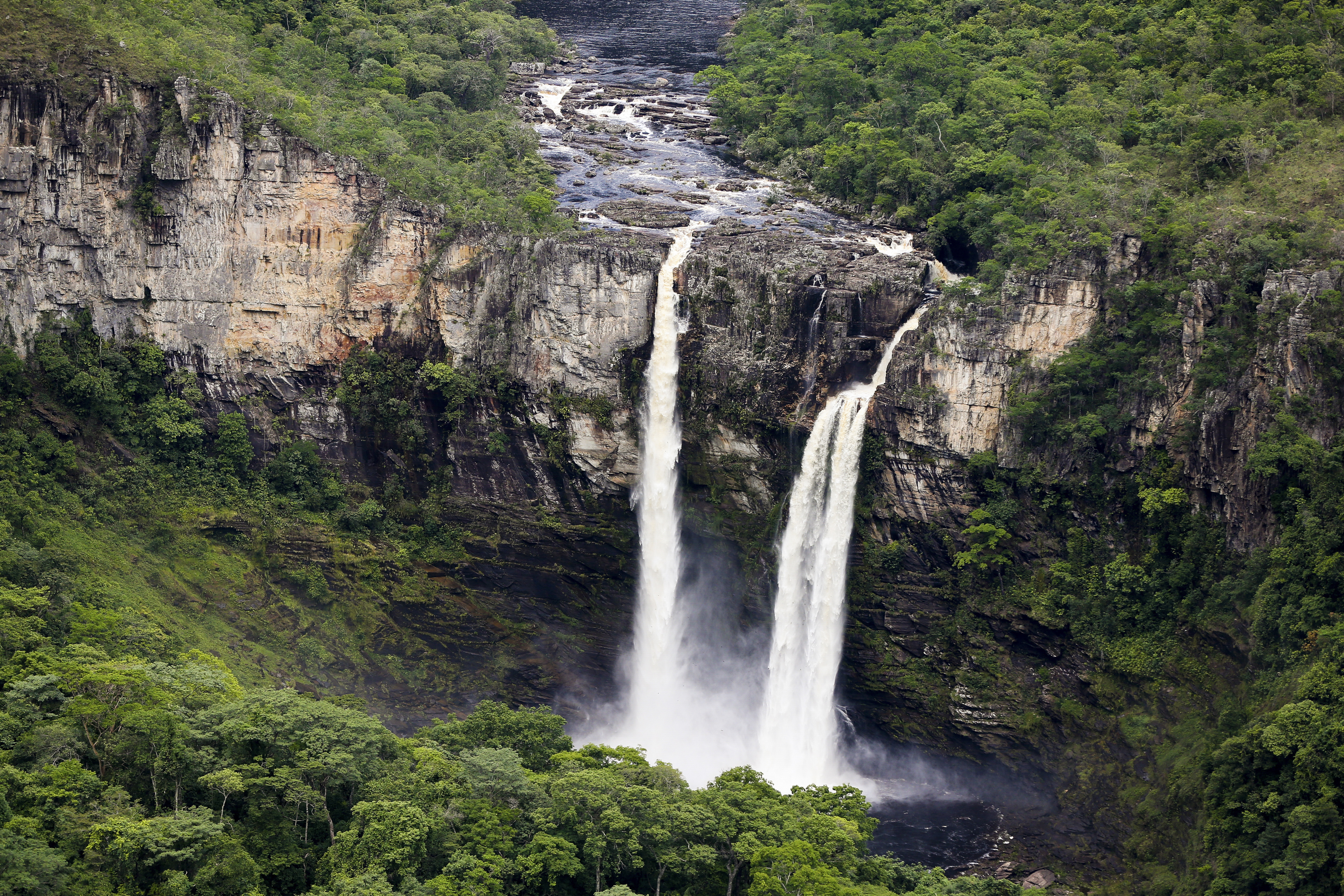|
Giant Armadillo
The giant armadillo (''Priodontes maximus''), colloquially ''tatu-canastra'', ''tatou'', ''ocarro'' or ''tatú carreta'', is the largest living species of armadillo (although their extinct relatives, the glyptodonts, were much larger). It lives in South America, ranging throughout as far south as northern Argentina. This species is considered vulnerable to extinction. The giant armadillo prefers termites and some ants as prey, and often consumes the entire population of a termite mound. It also has been known to prey upon worms, larvae and larger creatures, such as spiders and snakes, and plants. Some giant armadillos have been reported to have eaten bees by digging into beehives. At least one zoo park, in Villavicencio, Colombia – ''Los Ocarros'' – is dedicated to this animal. Description The giant armadillo is the largest living species of armadillo, with 11 to 13 hinged bands protecting the body and a further three or four on the neck. Its body is dark brown in c ... [...More Info...] [...Related Items...] OR: [Wikipedia] [Google] [Baidu] |
Villavicencio
Villavicencio () is a city and municipality in Colombia. Capital of Meta Department, it was founded on April 6, 1840. The city had an urban population of approximately 531,275 inhabitants in 2018.https://www.dane.gov.co/files/varios/informacion-capital-DANE-2019.pdf The city is located at 4°08'N, 73°40'W, 75 km (about 45 mi) southeast of the Colombian capital city of Bogotá (DC) by the Guatiquía River. It is the most important commercial center in the Llanos Orientales (Eastern plains). It has a warm and humid climate, with average daily temperatures ranging from 21 °C to 30 °2It is affectionately called "Villavo" la bella. Lying in a rural zone of tropical climate, Villavicencio is on the great Colombian-Venezuelan plain called the Llanos, which is situated to the east of the Andes mountains. Villavicencio is also called "La Puerta al Llano", or "The Gateway to the Plains", due to its location on the historical path from the Colombian interior to the ... [...More Info...] [...Related Items...] OR: [Wikipedia] [Google] [Baidu] |
Salta Province
Salta () is a province of Argentina, located in the northwest of the country. Neighboring provinces are from the east clockwise Formosa, Chaco, Santiago del Estero, Tucumán and Catamarca. It also surrounds Jujuy. To the north it borders Bolivia and Paraguay and to the west lies Chile. History Before the Spanish conquest, numerous native peoples (now called Diaguitas and Calchaquíes) lived in the valleys of what is now Salta Province; they formed many different tribes, the Quilmes and Humahuacas among them, which all shared the Cacán language. The Atacamas lived in the Puna, and the Wichís (Matacos), in the Chaco region. The first conquistador to venture into the area was Diego de Almagro in 1535; he was followed by Diego de Rojas. Hernando de Lerma founded San Felipe de Lerma in 1582, following orders of the viceroy Francisco de Toledo, Count of Oropesa; the name of the city was soon changed to "San Felipe de Salta". By 1650, the city had around five hundred ... [...More Info...] [...Related Items...] OR: [Wikipedia] [Google] [Baidu] |
Habitat Loss
Habitat destruction (also termed habitat loss and habitat reduction) is the process by which a natural habitat becomes incapable of supporting its native species. The organisms that previously inhabited the site are displaced or dead, thereby reducing biodiversity and species abundance. Habitat destruction is the leading cause of biodiversity loss. Fragmentation and loss of habitat have become one of the most important topics of research in ecology as they are major threats to the survival of endangered species. Activities such as harvesting natural resources, industrial production and urbanization are human contributions to habitat destruction. Pressure from agriculture is the principal human cause. Some others include mining, logging, trawling, and urban sprawl. Habitat destruction is currently considered the primary cause of species extinction worldwide. Environmental factors can contribute to habitat destruction more indirectly. Geological processes, climate change, ... [...More Info...] [...Related Items...] OR: [Wikipedia] [Google] [Baidu] |
San Antonio Zoo
The San Antonio Zoo is an Association of Zoos and Aquariums-accredited zoo in Midtown San Antonio, Texas, United States. It is located in the city's Brackenridge Park. San Antonio Zoo is a 50+ acre zoo home to over 750 species, some of which are endangered or extinct in the wild, and an annual attendance of more than 1 million. It also runs non-animal attractions, such as the narrow gauge San Antonio Zoo Eagle train ride, which first opened in 1956 and utilizes three Chance Rides C.P. Huntington locomotives. The Richard Friedrich Aquarium was opened in 1948. It was the only aquarium in the city until SeaWorld San Antonio was opened in 1988. History What is now known as the San Antonio Zoo began in 1914 when Colonel George Washington Brackenridge, one of the city's leading citizens, placed bison, deer, monkeys, African lions, and bears on land he had deeded to the city. The land became Brackenridge Park and Golf Course. The San Antonio Zoo opened two of the first cageless ... [...More Info...] [...Related Items...] OR: [Wikipedia] [Google] [Baidu] |
Teat
A teat is the projection from the mammary glands of mammals from which milk flows or is ejected for the purpose of feeding young. In many mammals the teat projects from the udder. The number of teats varies by mammalian species and often corresponds to the average litter size for that animal. In some cases, the teats of female animals are milked for the purpose of human consumption. The quality of some domesticated animals is determined by the establishment of desired characteristics, such as teat size and placement. Number and positioning in animals The number and positioning of mammary glands and teats varies widely among mammals. The protruding teats and accompanying glands can be located anywhere along the two milk lines. In general most mammals develop mammary glands in pairs along these lines, with a number approximating the number of young typically birthed at a time. The number of teats varies from 2 (in elephants and anthropoids) to 18 (in pigs). Marsupials usually ... [...More Info...] [...Related Items...] OR: [Wikipedia] [Google] [Baidu] |
Fossorial
A fossorial () animal is one adapted to digging which lives primarily, but not solely, underground. Some examples are badgers, naked mole-rats, clams, meerkats, and mole salamanders, as well as many beetles, wasps, and bees. Prehistoric evidence The physical adaptation of fossoriality is widely accepted as being widespread among many prehistoric phyla and taxa, such as bacteria and early eukaryotes. Furthermore, fossoriality has evolved independently multiple times, even within a single family. Fossorial animals appeared simultaneously with the colonization of land by arthropods in the late Ordovician period (over 440 million years ago). Other notable early burrowers include '' Eocaecilia'' and possibly ''Dinilysia''. The oldest example of burrowing in synapsids, the lineage which includes modern mammals and their ancestors, is a cynodont, '' Thrinaxodon liorhinus'', found in the Karoo of South Africa, estimated to be 251 million years old. Evidence shows t ... [...More Info...] [...Related Items...] OR: [Wikipedia] [Google] [Baidu] |
Short-eared Dog
The short-eared dog (''Atelocynus microtis''), also known as the short-eared zorro or small-eared dog,de la Rosa, Carlos L.; and Nocke, Claudia. A Guide to the Carnivores of Central America: Natural History, Ecology, and Conservation. Austin: University of Texas Press; 2000. Accessed on November 4, 2015 at: https://books.google.com/books?id=x5ihAwAAQBAJ&pg=PT292&lpg=PT292&dq=bush+dog+central+america&source=bl&ots=yUIbt476FL&sig=c50Gn5E--FqYOvjfOEMqUzCIDnM&hl=en&sa=X&ved=0CEQQ6AEwCWoVChMI3Mmbn5z3yAIVgRk-Ch330A__#v=onepage&q=bush%20dog%20central%20america&f=false is a unique and elusive canid species endemic to the Amazonian basin. This is the only species assigned to the genus ''Atelocynus''. Other names The short-eared dog has many names in the local languages where it is endemic, including ' in Portuguese, ' ("short-ear fox") in Spanish, ' in Chiquitano, ' in Yucuna, ' in Guarayu, ' in Mooré, and ''achuj'' in Ninam and Mosetén. Other common names in Spanish include ' ("b ... [...More Info...] [...Related Items...] OR: [Wikipedia] [Google] [Baidu] |
Invertebrate
Invertebrates are a paraphyletic group of animals that neither possess nor develop a vertebral column (commonly known as a ''backbone'' or ''spine''), derived from the notochord. This is a grouping including all animals apart from the chordate subphylum Vertebrata. Familiar examples of invertebrates include arthropods, mollusks, annelids, echinoderms and cnidarians. The majority of animal species are invertebrates; one estimate puts the figure at 97%. Many invertebrate taxa have a greater number and variety of species than the entire subphylum of Vertebrata. Invertebrates vary widely in size, from 50 μm (0.002 in) rotifers to the 9–10 m (30–33 ft) colossal squid. Some so-called invertebrates, such as the Tunicata and Cephalochordata, are more closely related to vertebrates than to other invertebrates. This makes the invertebrates paraphyletic, so the term has little meaning in taxonomy. Etymology The word "invertebrate" comes from the Latin word ''vertebra' ... [...More Info...] [...Related Items...] OR: [Wikipedia] [Google] [Baidu] |
Spider
Spiders (order Araneae) are air-breathing arthropods that have eight legs, chelicerae with fangs generally able to inject venom, and spinnerets that extrude silk. They are the largest order of arachnids and rank seventh in total species diversity among all orders of organisms. Spiders are found worldwide on every continent except for Antarctica, and have become established in nearly every land habitat. , 50,356 spider species in 132 families have been recorded by taxonomists. However, there has been debate among scientists about how families should be classified, with over 20 different classifications proposed since 1900. Anatomically, spiders (as with all arachnids) differ from other arthropods in that the usual body segments are fused into two tagmata, the cephalothorax or prosoma, and the opisthosoma, or abdomen, and joined by a small, cylindrical pedicel, however, as there is currently neither paleontological nor embryological evidence that spiders ever had a sep ... [...More Info...] [...Related Items...] OR: [Wikipedia] [Google] [Baidu] |
Worm
Worms are many different distantly related bilateral animals that typically have a long cylindrical tube-like body, no limbs, and no eyes (though not always). Worms vary in size from microscopic to over in length for marine polychaete worms (bristle worms); for the African giant earthworm, '' Microchaetus rappi''; and for the marine nemertean worm (bootlace worm), '' Lineus longissimus''. Various types of worm occupy a small variety of parasitic niches, living inside the bodies of other animals. Free-living worm species do not live on land but instead live in marine or freshwater environments or underground by burrowing. In biology, "worm" refers to an obsolete taxon, '' vermes'', used by Carolus Linnaeus and Jean-Baptiste Lamarck for all non-arthropod invertebrate animals, now seen to be paraphyletic. The name stems from the Old English word '' wyrm''. Most animals called "worms" are invertebrates, but the term is also used for the amphibian caecilians and the slow ... [...More Info...] [...Related Items...] OR: [Wikipedia] [Google] [Baidu] |
Nocturnal
Nocturnality is an ethology, animal behavior characterized by being active during the night and sleeping during the day. The common adjective is "nocturnal", versus diurnality, diurnal meaning the opposite. Nocturnal creatures generally have highly developed senses of hearing (sense), hearing, olfaction, smell, and specially adapted eyesight. Some animals, such as cats and ferrets, have eyes that can adapt to both low-level and bright day levels of illumination (see metaturnal). Others, such as bushbaby, bushbabies and (some) bats, can function only at night. Many nocturnal creatures including tarsiers and some owls have large eyes in comparison with their body size to compensate for the lower light levels at night. More specifically, they have been found to have a larger cornea relative to their eye size than diurnal creatures to increase their : in the low-light conditions. Nocturnality helps wasps, such as ''Apoica flavissima'', avoid hunting in intense sunlight. Diurnality ... [...More Info...] [...Related Items...] OR: [Wikipedia] [Google] [Baidu] |
Cerrado
The ''Cerrado'' (, ) is a vast ecoregion of tropical savanna in eastern Brazil, particularly in the states of Goiás, Mato Grosso do Sul, Mato Grosso, Tocantins, Minas Gerais, and the Federal District. The core areas of the Cerrado biome are the Brazilian highlands – the ''Planalto''. The main habitat types of the Cerrado consist of forest savanna, wooded savanna, park savanna and gramineous-woody savanna. The ''Cerrado'' also includes savanna wetlands and gallery forests. The second largest of Brazil's major habitat types, after the Amazonian rainforest, the Cerrado accounts for a full 21 percent of the country's land area (extending marginally into Paraguay and Bolivia). The first detailed European account of the Brazilian cerrados was provided by Danish botanist Eugenius Warming (1892) in the book ''Lagoa Santa'', : The above is the original. There are other, later French and Portuguese translations not listed here. in which he describes the main features of th ... [...More Info...] [...Related Items...] OR: [Wikipedia] [Google] [Baidu] |








